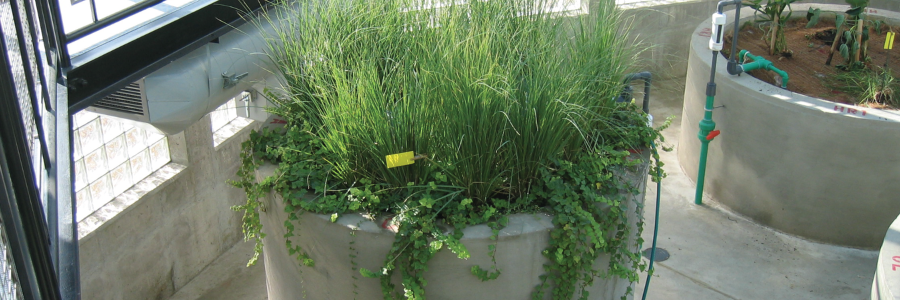Advanced Botanical Systems for Wastewater
What are Advanced Botanical Systems?
An Advanced Botanical System is an ecologically sequenced system that utilizes plants, bacteria and microorganisms for efficient, reliable and aesthetically pleasing wastewater treatment.
ADVANCED WETLAND TREATMENT SYSTEMS
An Advanced Wetland Treatment System (AWTS) is a subsurface-flow (SF) wetland that has been enhanced with Forced Bed Aeration, a patented technology in the United States (Wallace 2001, Wallace 2002a). Water is maintained at a constant depth below the surface of the porous media, which is usually gravel, and is typically between 18 to 48 inches (45 to 122 cm) deep throughout the wetland. The critical component for the successful operation of an AWTS is maintaining sufficient oxygen levels. Oxygen allows for the microbial degradation of organic matter in the form of BOD. Sufficient oxygen levels are often difficult to achieve in constructed wetlands without aeration systems. Plants and atmospheric diffusion are the two principal mechanisms for transferring oxygen into these systems (Kadlec and Knight, 1996; Kent, 1994; Good and Patrick, 1987). Studies have shown, however, that these mechanisms are insufficient to meet the oxygen demands exerted by most wastewater (Wu et al., 2001; Hammer and Knight, 1994), causing these systems to become anaerobic. The rate of anaerobic microbial degradation of the BOD is extremely slow, and odorous compounds such as sulfides, ammonia, and methane may be produced as a by-product. Other biological processes are inhibited by insufficient levels of dissolved oxygen (DO). For example, nitrification may not occur in constructed wetlands if DO concentrations are lower than 1.5 mg/L (Wolverton, 1987).
BOTANICAL AERATION MACHINE
The Botanical Aeration Machine (BAM) is a hybrid wetland technology combined with a completely mixed reactor. The result is a beautiful water garden that is capable of reducing high BOD strength wastewater in a small footprint, with minimal sludge production. An aerobic environment is created by submerged aeration diffusers that continuously pump air into the reactor, and subsequently provide vigorous mixing. This mixing facilitates microbial contact with the wastewater.
A robust ecosystem is created within the BAM between the plants, microbial species and distinct treatment zones. All the major groups of life are represented, including microscopic algae, fungi and bacteria to tiny animals called protozoa, on upward to snails, clams, fishes and free swimming water animals known as zooplankton. Higher plants, including shrubs and trees, are grown on industrial strength fiberglass racks that are suspended within the system. The result is an efficient and refined wastewater treatment system that is capable of achieving high quality water without the need for hazardous chemicals.
GARDEN MEDIA FILTERS
Garden Media Filters are a form of vertical flow subsurface wetland systems. Wastewater is distributed at top of the gravel media and flows down through the media, similar to a sand filter. It is collected and recirculated a number of times until it is clean. The result is a planted garden, where the water is never seen, but filtered across the plant roots and through the stone where it is naturally cleaned so that it can be safely reused or returned to the environment.
To learn more about how EcoSolutions can help you, give us a call at 802.878.7464 or contact us at EcoSolutions.

